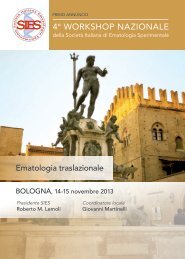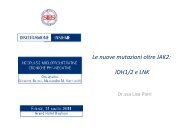Are Bcr-Abl KD mutations already detectable at the time ... - siesonline
Are Bcr-Abl KD mutations already detectable at the time ... - siesonline
Are Bcr-Abl KD mutations already detectable at the time ... - siesonline
- No tags were found...
You also want an ePaper? Increase the reach of your titles
YUMPU automatically turns print PDFs into web optimized ePapers that Google loves.
LAL:signific<strong>at</strong>o clinico e biologicodelle mutazioni di <strong>Bcr</strong>-<strong>Abl</strong>Simona SoveriniDipar<strong>time</strong>nto di Em<strong>at</strong>ologia e Scienze Oncologiche “L. e A. Seràgnoli”Università di Bologna
The vast majority of Ph+ ALL p<strong>at</strong>ientstre<strong>at</strong>ed with im<strong>at</strong>inib relapse wi<strong>the</strong>vidence of a <strong>Bcr</strong>-<strong>Abl</strong> <strong>KD</strong> mut<strong>at</strong>ion
Im<strong>at</strong>inib-resistant pts with Ph+ ALL have <strong>the</strong>highest incidence of <strong>Bcr</strong>-<strong>Abl</strong> <strong>KD</strong> <strong>mut<strong>at</strong>ions</strong>D<strong>at</strong>a of <strong>the</strong> GIMEMA WP on CML on 655 IM-resistant ptsPhase <strong>at</strong> <strong>the</strong> <strong>time</strong> of IM failure:CP (IM first-line) AP/BC CML Ph+ ALL30%64%76%resistant pts harbouring <strong>Abl</strong> <strong>KD</strong> <strong>mut<strong>at</strong>ions</strong>
T315I is <strong>the</strong> single most frequent <strong>Bcr</strong>-<strong>Abl</strong><strong>KD</strong> mut<strong>at</strong>ion in im<strong>at</strong>inib-resistant Ph+ ALL66 <strong>mut<strong>at</strong>ions</strong> in 62/82 ptsresistant to im<strong>at</strong>inibT315I <strong>mut<strong>at</strong>ions</strong>: 17/66 (26%)*P-loop <strong>mut<strong>at</strong>ions</strong>: 26/66 (39%)P-loopc<strong>at</strong>alyticdomainactiv<strong>at</strong>ionloopM244VL248VG250EQ252R/HY253F/HD276GT277AE255K/VE279KV289AE281A/KE292VM343TH396R/PL364IM351TL387M/FL384MF359V/IS417Y/FT315I E355G/DF382L E453G/KV379IF311L/I F317LE459K/QA380TF486S* Frequency of T315I <strong>mut<strong>at</strong>ions</strong> in im<strong>at</strong>inib-resistant CML: ~10-12%
Second-line TKIs in im<strong>at</strong>inib resistant Ph+ ALLp<strong>at</strong>ients have limited efficacyCHRmCgRF311IV299LNELG250ECHRCCgRF317LY253HCHRCCgRT315IWTCHR100T315IE255KCHRCCgRE255K,T315ID276GCHR PCgR100T315IWTCHR100F317LE255KCHRCCgRT315IY253HCHRCCgRT315A, F317LM351TCHRCCgR90M351T, F317LWTCHRF317IL387ML387M,F317Lmonths on das<strong>at</strong>inib0 1 2 3 6 9 12 15
Inhibiting <strong>Bcr</strong>-<strong>Abl</strong> in Ph+ ALL is likeshooting <strong>at</strong> a moving targetdas<strong>at</strong>inibim<strong>at</strong>inib 800nilotinib0141618monthsMale, 18 yrs, Ph+ ALLWTT315AY253HY253HT315AWTT315AWTT315AT315AT315AT315AY253HWTT315AG250ET315AG250ET315AG250ET315AY253HWT3 WTWT CCgR, MMRWTWTrelapserelapserelapseim<strong>at</strong>inibdas<strong>at</strong>inibnilotinib0121822monthsMale, 69 yrs, Ph+ ALLG250EG250EWTG250EWTWTWTWTG250EF317LG250E WTF317LG250EF317LY253HY253HWT G250EF317L WTG250EF317L Y253Hrelapserelapserelapse
In ALL genetic instability is high and allows<strong>the</strong> Ph+ clone to rapidly escape inhibitionNovel TKIs are active against <strong>the</strong> vast majority of IM-resistant <strong>mut<strong>at</strong>ions</strong>, but<strong>the</strong>y inexorably retain one or some insensitive <strong>mut<strong>at</strong>ions</strong>Disease burdenIMATINIB INHIBITOR 2 INHIBITOR 3 ??<strong>time</strong>RELAPSE 1 RELAPSE 2 RELAPSE 3BCR-ABL <strong>KD</strong> sequenceWT(?)IM-res mut<strong>at</strong>ionAccumul<strong>at</strong>ion of compounddrug-resistant <strong>mut<strong>at</strong>ions</strong>
<strong>Are</strong> <strong>Bcr</strong>-<strong>Abl</strong> <strong>KD</strong> <strong>mut<strong>at</strong>ions</strong> <strong>already</strong><strong>detectable</strong> <strong>at</strong> <strong>the</strong> <strong>time</strong> of diagnosis?• In Ph+ ALL pts tre<strong>at</strong>ed with im<strong>at</strong>inib, resistance-associ<strong>at</strong>ed<strong>Bcr</strong>-<strong>Abl</strong> <strong>KD</strong> <strong>mut<strong>at</strong>ions</strong> arise more frequently and more rapidlythan in CML pts• Im<strong>at</strong>inib does not to induce <strong>mut<strong>at</strong>ions</strong>, but simply selectspre-existent mut<strong>at</strong>ed clonesIn how many newly diagnosed Ph+ ALL can we detect <strong>Bcr</strong>-<strong>Abl</strong><strong>KD</strong> <strong>mut<strong>at</strong>ions</strong> <strong>at</strong> low levels?
<strong>Are</strong> <strong>Bcr</strong>-<strong>Abl</strong> <strong>KD</strong> <strong>mut<strong>at</strong>ions</strong> <strong>already</strong><strong>detectable</strong> <strong>at</strong> <strong>the</strong> <strong>time</strong> of diagnosis?• German experience: <strong>Bcr</strong>-<strong>Abl</strong> <strong>KD</strong> <strong>mut<strong>at</strong>ions</strong> detected by D-HPLC <strong>at</strong> <strong>the</strong> <strong>time</strong> of diagnosis in:- 9/22 (41%) cases in elderly pts (Pfeifer et al, Blood 2007)– 6/34 (18%) cases in younger pts (Pfeifer et al, EHA 2008)• Lower detection limit of D-HPLC is routinely 5-10%• Wh<strong>at</strong> happens if we increase <strong>the</strong> sensitivity of ourscreening method?
P<strong>at</strong>ients (I)→ RNA samples collected <strong>at</strong> <strong>the</strong> <strong>time</strong> of diagnosis from13 p<strong>at</strong>ients enrolled on a phase II study of <strong>the</strong> tre<strong>at</strong>mentof adult de novo Ph+ ALL with das<strong>at</strong>inib (GIMEMA LAL1205)DASATINIB 70 mg BIDPDNi.t. mtxi.t. mtx-6 0 +1 +22 +32 +43+84 days
P<strong>at</strong>ients (II)NSexAge<strong>Bcr</strong>-<strong>Abl</strong> typeSt<strong>at</strong>us (<strong>time</strong> from<strong>the</strong> start of das<strong>at</strong>inib,mo)Mut<strong>at</strong>ion <strong>at</strong>diagnosis(direct seq)Mut<strong>at</strong>ion <strong>at</strong>relapse(direct seq)1M49p190Relapsed (10)WTT315I2M56p210Relapsed (6)WTT315I3M56p210Relapsed (7)WTWT4F47p190Relapsed (4)WTWT5F74p210Relapsed (8)WTT315I6F58p210Relapsed (7)WTE255K7F59p210Relapsed (2)WTT315I8F30p210Relapsed (6)WTT315I9F57p190Remission (13)WTN.A.10F34p190Remission (5)WTN.A.11M52p190Remission (12)WTN.A.12F73p210Remission (23)WTN.A.13M72p190Remission (20)WTN.A.N.A., not applicable
Experimental designWT Y342Y E292GBCR<strong>KD</strong>ABL1.Amplific<strong>at</strong>ion of<strong>the</strong> BCR-ABL <strong>KD</strong>(a.a 206-524)by nestedRT-PCR andlig<strong>at</strong>ion into aplasmidlacZlacZpCR2.1TOPOvectorAMP R4.Directsequencing of150 to 200independentclones2.Transform<strong>at</strong>ionof E. colicompetent cells3.Pl<strong>at</strong>ing andovernightincub<strong>at</strong>ion<strong>at</strong> 37°C
Results (I)Aberrant <strong>Bcr</strong>-<strong>Abl</strong> <strong>KD</strong> sequences were detectedin ALL <strong>the</strong> p<strong>at</strong>ientsinsertionsdeletionspoint <strong>mut<strong>at</strong>ions</strong>missense (→ amino acid change)silent (→ no amino acid change)nonsense (→ prem<strong>at</strong>ure stop codon)N216139184
Results (II)Point <strong>mut<strong>at</strong>ions</strong> were randomly and uniformly distributedall over <strong>the</strong> <strong>KD</strong>Most of <strong>the</strong>m were not likely to be clinically relevantP-loop C-helix SH3 contact SH2 contact A-loopP216P K245R Y257H E275E E292G T315I E334E I360T T392I Q477stopK222E G249S Y264C E281K I293T F317L V335V A366A H396PD223N G250RA288T V304I/A T319A N336D R367stop I403TG227G Q252stop V289A R307Q Y326Y A337A K378E W405CV228A Y253YL327L Y342Y A380A A407AS229T/P G254EA344T L384PC346stop T389TE352G/KY353YMut<strong>at</strong>ions th<strong>at</strong> have been reported in im<strong>at</strong>inib-resistant pts are highlighted
N12345678910111213St<strong>at</strong>us (<strong>time</strong> from<strong>the</strong> start ofdas<strong>at</strong>inib, mo)Relapsed (10)Relapsed (6)Relapsed (7)Relapsed (4)Relapsed (8)Relapsed (7)Relapsed (2)Relapsed (6)Remission (13)Remission (5)Remission (12)Remission (23)Remission (20)Results (III)Each In In two contrast, p<strong>at</strong>ients, had an <strong>the</strong> F317L evidence T315I detected observed of two <strong>at</strong> to diagnosis <strong>at</strong> twelve relapse different failed could to <strong>already</strong> <strong>mut<strong>at</strong>ions</strong> expandbedetected <strong>at</strong> <strong>the</strong> <strong>time</strong> of diagnosisSexMMMFFFFFFFMFMAge49565647745859305734527372<strong>Bcr</strong>-<strong>Abl</strong>typep190p210p210p190p210p210p210p210p190p190p190p210p190Mut<strong>at</strong>ions* <strong>at</strong> diagnosis (total no. of clones sequenced)L266P; A337A (150)K222E; V289A; V335V; K378E (180)V228A; R307Q; W405C (150)E275E; E281K; T319A; N336D (200)K245R; I293T; V304I; D363D; R367stop; K378E; 39 bp ins (180)G250R; L327L; I360T (150)G227G; I293T; V304I; T315I; C346stop; W405C (200)P216P; Y264C; T315I; A344T (150)D223N; S229T; Q252stop; L384P; T392I; A407A;del(cggga)1343 (200)S229P; K245R; A288T; 171 bp ins (200)G254E; Y326Y; E334E (150)E286E; E352K; A380A; T389T; Q477stop (150)G249S; Y253Y; Y257H; E292G; T304A; F317L; Y342Y; E352G;Y353Y; A366A; H396P; I403T (200)* Each mut<strong>at</strong>ion was detected by bidirectional sequencing in 2 to 5 independent clonesMut<strong>at</strong>ion <strong>at</strong>relapse(direct seq)T315IT315IWTWTT315IE255KT315IT315IN.A.N.A.N.A.N.A.N.A.
Results (IV)55/61(90%) nucleotide substitutions were transitionsTransitions:G>AA>GT>CC>TTotalTransversions:G>TA>TT>AT>GA>CTotal1514131355211116Such a high prevalenceof transitions (whichnormally occur 1.4 <strong>time</strong>smore frequently thantransversions) suggeststh<strong>at</strong> a specific mechanismgener<strong>at</strong>ing <strong>mut<strong>at</strong>ions</strong> ispredominant
Take-home messagesa) <strong>Bcr</strong>-<strong>Abl</strong> <strong>KD</strong> <strong>mut<strong>at</strong>ions</strong> can probably be found <strong>at</strong> <strong>the</strong><strong>time</strong> of diagnosis in all Ph+ ALL ptsb) TKI-resistant <strong>mut<strong>at</strong>ions</strong> present <strong>at</strong> low levels <strong>at</strong>diagnosis do not always outgrow and lead to relapse,probably because some of <strong>the</strong>m arise in cell cloneswith limited self-renewal capacityc) It is essential to understand <strong>the</strong> molecularmechanism(s) sustaining this “mut<strong>at</strong>or phenotype” aswell as how to <strong>the</strong>rapeutically interfere with <strong>the</strong>m
AcknowledgmentsDepartment of Hem<strong>at</strong>ology and Oncological Sciences “L. e A. Seràgnoli”,University of Bologna, ItalyMichele BaccaraniGiovanni MartinelliAlessandra GnaniSabrina ColarossiStefania PaoliniIlaria IacobucciCristina PapayannidisAnnalisa LonettiMarilina AmabileDepartment of Hem<strong>at</strong>ology and Cellular Biotechnologies, “La Sapienza” University,Rome, ItalyRobin FoàAntonella VitaleMarco VignettiLoredana EliaGiovanna MeloniAnna GuariniFranco MandelliGIMEMA ALL WORKING PARTY


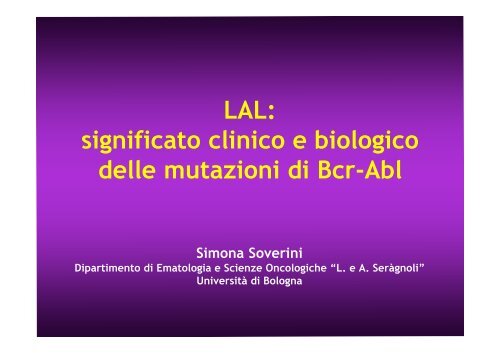
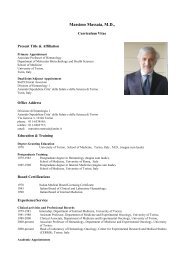
![Bosi TKI in cGVHD SIES 2011 per Bosi.ppt [Sola lettura] - siesonline](https://img.yumpu.com/48115694/1/190x135/bosi-tki-in-cgvhd-sies-2011-per-bosippt-sola-lettura-siesonline.jpg?quality=85)
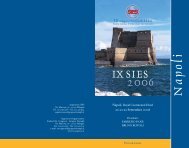

![comoli_Pg_WkShpSIES11.ppt [Sola lettura] - siesonline](https://img.yumpu.com/40543361/1/190x135/comoli-pg-wkshpsies11ppt-sola-lettura-siesonline.jpg?quality=85)
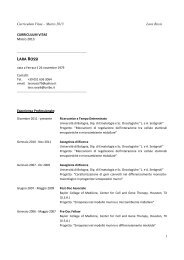


![C-Camaschella.pptx [Sola lettura] - siesonline](https://img.yumpu.com/33182884/1/190x135/c-camaschellapptx-sola-lettura-siesonline.jpg?quality=85)
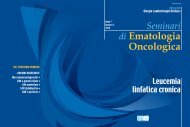
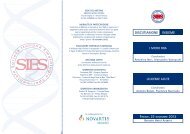
![01 Ghia.ppt [Sola lettura] - siesonline](https://img.yumpu.com/31878896/1/184x260/01-ghiappt-sola-lettura-siesonline.jpg?quality=85)
